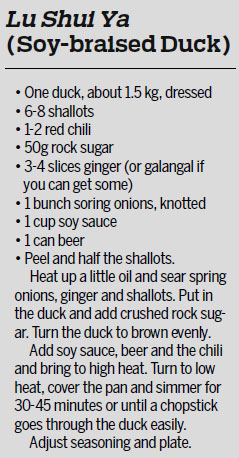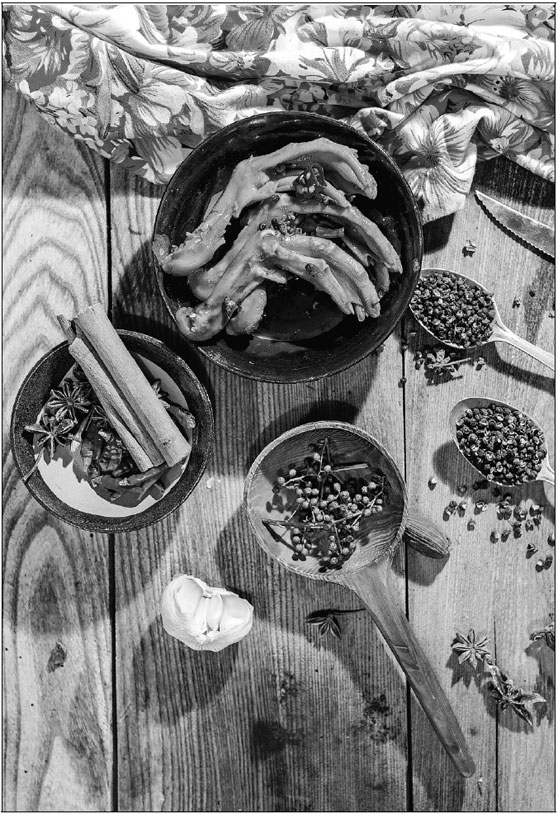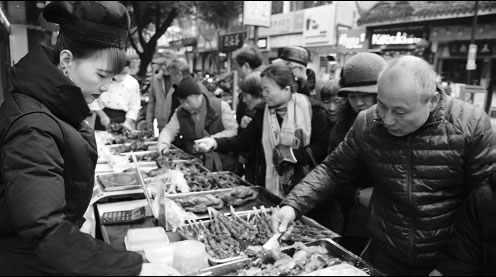Dark, light and white brews
One of the best known methods of Chinese cooking is to slowly simmer poultry and meats in a saucy, spiced brew.
This style of braising is known as lu, after the flavorful brew the food is cooked in. All over China from region to region, there is always a recipe for braising, a version of lu.
In the north, the braising brew is dark and redolent of strong spices, notably that of star anise, cardamom, cinnamon and Sichuan peppercorns. The heavy dark soy sauce colors the braising liquid and hence, the goods.
Duck gizzards, beef shins, pig trotters, tongues, pieces of liver, sometimes even whole spring chickens will go into the constantly simmering pot.
|
The method of slowly simmering poultry and meats in a saucy, spiced brew is called lu, a style of cooking that helps brew the food to be cooked in. Photos Provided to China Daily |
|
The meats are lifted from the pot and drained, then cooled and sold. |
In a separate pot, pieces of hard and soft tofu, bean curd skins and other tofu products will also cook. These are never mixed with the meats because the tofu may start off an unwanted fermenting.
One thing that differentiates the northeastern brews from the other regions. The meats are lifted from the pot and drained, then cooled. They are then displayed, and sliced and packed off only when an order comes in. The braising liquid is almost never seen.
The northern braises are also more full-flavored, salty and strong. This tradition harks back to times when there was little refrigeration and the meats depended on salt to keep palatable.
As we travel south, another famous brew appears. This is Nanjing's famous saltwater duck.
Its name is deceptively simple, but the duck is subjected to a dry rub marinade first and then steeped in a lao lu, a braising liquid that has seen the presence of countless ducks. As a result, this brew captures their essence and improves with age.
There have been many stories about how that pot of braising liquid has survived war and pestilence when chefs risked their lives to protect their precious brew.
Personally, I know of a respected chef who had transferred half a pot to a newly opened branch restaurant. An unknowing apprentice took a look at the dirty-looking brew and threw it out with the dishwater. Needless to say, that reckless act cut short his culinary ambitions.
The Nanjing saltwater duck has become a signature dish of the city, and its flavors more than match its reputation. It uses a spicy dry rub that is carefully brushed off before it is lowered into the simmering broth where it is kept just below boiling.
You can call this the original sous vide. The slow bath in the flavorful stock allows the flavors to penetrate every fiber, and the result is a tender duck with flesh that is exceedingly savory.
As a southerner, and a Cantonese to boot, I take pride in the braised foods of my home province, where all manner of lu, from light to dark flavor everything from pigeons to ducks, geese to chickens.

Here, the braising brews are flavored by light and dark soy sauces, the best Shaoxing wine, and even fermented bean curds.
There are the rose-scented soy chickens, still pink in the bones but with flesh that melts in the mouth. They are soaked in flavored soy brews started with gingers, scallions and scented with Shaoxing wine and meiguilu, a rose-steeped liquor originally from Tianjin.
That's the upmarket version. For the common folks, a basin of simmering low gaiyik will serve many and accompany heaping bowls of rice.
Low gaiyik or braised chicken wings, is more a generic rather than specific name. In addition to the chicken wings, there are intestines, gizzards, salted vegetables, tofu, bean curd skins all simmering happily together in a thick brew made from red fermented bean curd or nanru.
You could order a mixed plate and together with rice, it would make a delicious meal.
Cantonese brews are always started with aromatics that include ginger, scallions or even garlic. The spices are less prominent and a little piece of cinnamon or a couple of star anise pods are all that are needed.
One main ingredient is sugar, either crystallized rock sugar, or the flat golden slabs of natural cane sugar.
Once you get the basic brew right, you can cook almost anything in it, from pigeons to belly pork, trotters to gizzards.
For poultry such as duck and geese, galangal and shallots are added to the starter, a culinary influence brought back by Chaoshan cooks who returned from Southeast Asia.
The blue ginger adds a distinctive fragrance to the birds, and the shallots melt into the braising brew for added sweetness.
There is a whole cookbook to be written about lu shui and all its distinctive variations. Let's start with just one recipe.
paulined@chinadaily.com.cn
|
The northern braises are more full-flavored, salty and strong. The braising brew is dark and redolent of strong spices, notably that of star anise, cardamom, cinnamon and Sichuan peppercorns. |
(China Daily Global 10/16/2019 page15)





















